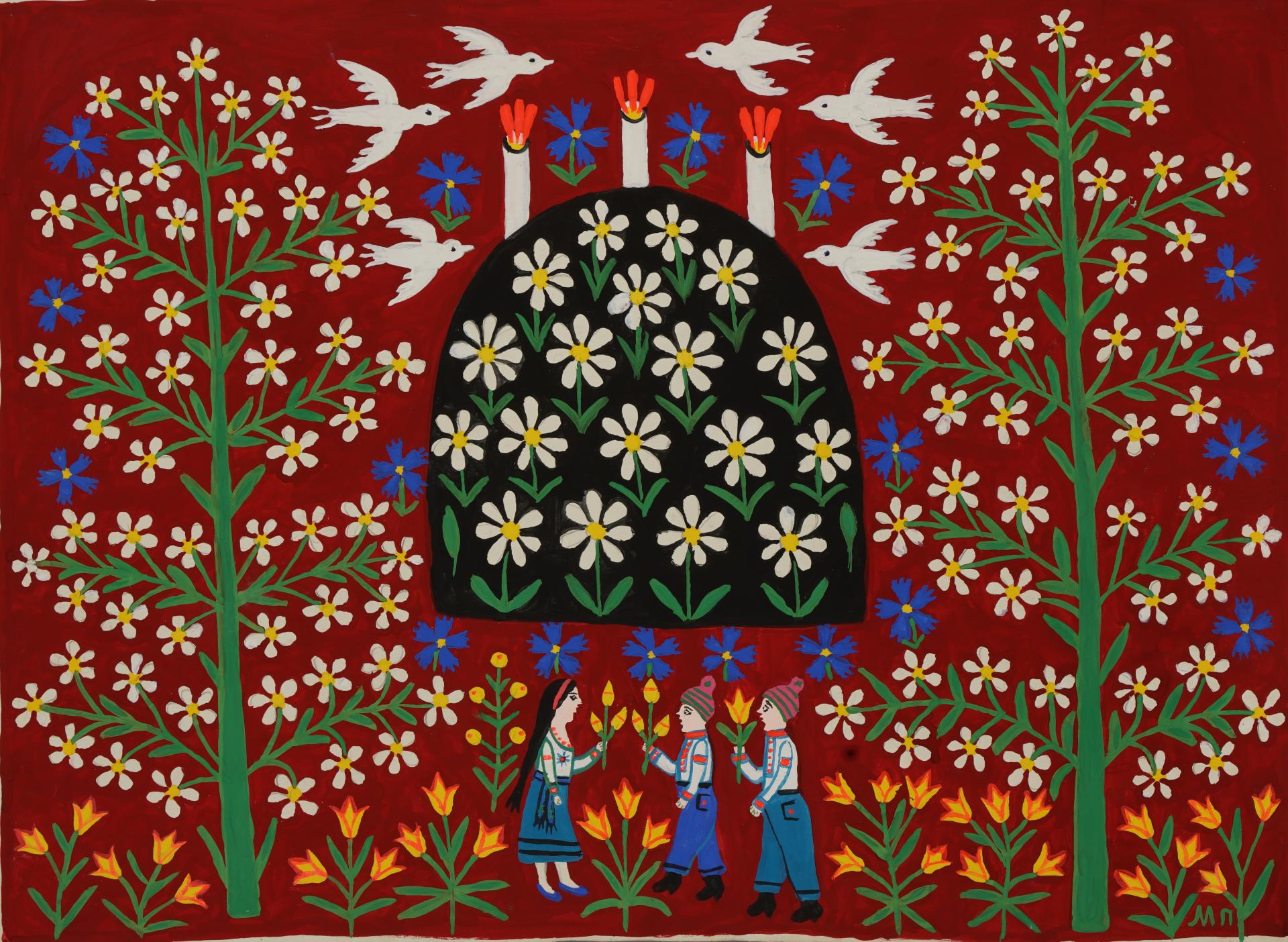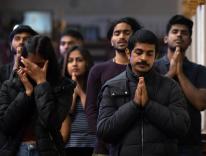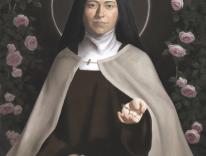The magpie is dressed to impress—and knows it. She wears a multi-strand red necklace, a floral crown, and a traditional blouse with embroidered patterns that extend to the tips of her wings. A dazzling set of peacock feathers is arrayed around her. On the left of the frame, a bird, bear, rabbit, and frog look on, musical instruments at the ready. They are rendered simply but expertly, their folksy horns and cymbals evoking the joy of an impending celebration.
The whimsy, cultural pride, and raw artistic talent on display in A Ukrainian Magpie Summons an Orchestra for a Wedding is typical of the work of renowned Ukrainian artist Maria Prymachenko. Hers is a world where animals emote, colors collide, and patterns dance. Though Prymachenko died in 1997 at the age of eighty-eight, she remains one of Ukraine’s most beloved artists. Since the start of Russia’s full-scale invasion in 2022, her work has served as a powerful symbol of Ukrainian identity both domestically and abroad, appearing on everything from murals expressing solidarity with Ukraine to minivans ferrying soldiers to the frontline.
Even so, like most Ukrainian cultural figures, Prymachenko is little known in the United States. A large, thrilling exhibit at the Ukrainian Museum in New York City through April 7, her first retrospective outside Europe, gives American visitors an unprecedented opportunity to view her oeuvre. It also complicates our understanding of Prymachenko, presenting her not just as a cultural figurehead, but as an artist who was forged by Ukraine’s tragic twentieth century, and whose career and work bear its indelible mark.
In many ways, Prymachenko fit the profile of a quintessential folk artist. Born in 1909 in the village of Bolotnya, in the Polissya region north of Kyiv, she had a typical rural Ukrainian childhood. She stopped attending school after fourth grade, hardly unusual for a society where older children usually became full-time farm laborers. A bout with polio around age seven left her partly paralyzed, unable to work, and removed from her peers. Thereafter, Prymachenko’s main sphere of activity became art. (In this, she took after her mother, a talented embroideress.) In her twenties, Prymachenko’s work was discovered by a Kyiv artist, Tetiana Floru, and in 1936, she was invited to the capital to attend the Central Experimental Workshops in Folk Art at the Kyiv State Museum of Ukrainian Art.
It was a lucky break in many ways. The 1930s were a nightmarish time in Soviet Ukraine. In the early part of the decade, Stalin’s attempt to collectivize the countryside resulted in a severe famine, known as the Holodomor, that killed at least three million people. (Prymachenko’s family presumably experienced the famine, though how they survived is unknown.) Later, he orchestrated the Great Terror, which claimed hundreds of thousands of lives and devastated Soviet Ukraine’s intelligentsia.
Prymachenko was handled very differently. The Communist Party approved of folk art, treating it as a means to celebrate the rural proletariat while honoring the distinct national cultures within the Soviet Union. It was also a way for the regime to advance a controlled and optimistic version of Ukrainian culture, even as it systematically—and often brutally—reshaped Ukrainian society. “The harsher the attacks on the traditional foundations of peasant life,” observed the art historian Halyna Sklyarenko, “the more actively folk art was promoted to ‘the first ranks of national culture.’”
As the Soviet secret police shot or imprisoned Ukrainian writers, dramatists, and artists, Prymachenko studied at an art school on the picturesque grounds of the Kyiv Pechersk Lavra, the capital’s most stunning monastery. It was there that she began to paint seriously. That output, some of which is on display at the Ukrainian Museum, shows the talent and imagination that would bloom in her later works. She was invited to show her work in Moscow, St. Petersburg, and Paris. The flourishing was personal, too: she underwent operations to improve her polio-stricken leg and began a romance with a man named Vasyl.
But luck did not hold long for anyone in Soviet Ukraine under Stalin. By 1941, Vasyl had died fighting in World War II, and Prymachenko was back in Bolotnya, living as a single mother. Her brother, who worked at a local collective farm, was executed. We know little about the other horrors Prymachenko may have seen or experienced during the war; the most revealing detail may be that, during this period, she stopped painting.
When Prymachenko consistently returned to the easel in the late 1940s, it was as a more confident and ambitious artist. Her canvases became bigger and her colors bolder, aided by a switch from watercolors to acrylics. Her ornamental motifs, which had always displayed a masterful command of symmetry, expanded in size and complexity. The scenes she depicted became more elaborate. In the coming decades, Prymachenko would produce hundreds of paintings of subjects that became her trademark: animals, especially birds and creatures she called “beasts”; flowers; scenes celebrating Taras Shevchenko, Ukraine’s unofficial national bard; weddings; and depictions of farming or domestic life.
The Soviet cultural machine advanced a limited view of Prymachenko. She was cast as a “naive old lady in a headscarf,” one who merely painted flowers and fanciful beasts, as art historian Oksana Semenik writes in her monograph accompanying the exhibition. It is unclear whether the Soviet elite failed to see the darker and more subversive spirit of Prymachenko’s paintings, or merely wanted to avoid drawing attention to it. Regardless, such a reductive view misses a crucial part of what makes Prymachenko’s work extraordinary.
Pain, fear, and loss figure surreally in many of her paintings, suggested by her use of dark colors, the looks of alarm or menace on the faces of some creatures, and their often uncanny, creepy forms. For Prymachenko, her art was a way to represent the horrors she had witnessed, particularly during the Second World War. “I spent so much time thinking about that war—hours, days, difficult years. I always wanted it to be preserved in my paintings,” she said. “I depicted the war itself, which I saw with my own eyes, its beastly guts.” Even a painting that at first glance may seem cheery can host a lurking threat: “Above everything shines the sun, which resembles a sunflower, but also a clawed beast,” wrote the literary critic Tamara Hundorova.

Prymachenko’s work also manages to engage critically with the Soviet system. Some of her most mesmerizing paintings are the ones she made in the aftermath of the nuclear catastrophe at Chornobyl. The disaster unfolded close to home, literally: Prymachenko’s village of Bolotnya is about thirty miles from the site of the meltdown, and the artist, then in her late seventies, disregarded the Soviet authorities’ guidance to evacuate. One of the most powerful paintings in this series on display at the Ukrainian Museum is a flower-filled homage to the fourth reactor at the Chornobyl power plant. The petals and stems are arranged in beautiful symmetry, recalling Prymachenko’s early embroidery. Doves fly above the reactor while children dressed in traditional Ukrainian clothing bring flowers to lay at its base. The scale of the splendor in the painting conveys the loss at its heart. Evidently, the Soviet authorities feared the impact of that message: none of Prymachenko’s Chornobyl work was made public until after the collapse of the Soviet Union.
Prymachenko often added long and revealing captions to her work as her career progressed, employing idiosyncratic grammar in her local Polissyan dialect. At turns lyrical, sarcastic, and heartfelt, they are an art all their own. One caption, written on the back of her Chornobyl painting, is especially moving: “This is how the fourth reactor came to me in a dream. Flowers will grow on it. And children will bring flowers. Everything around it will be like a memorial forever. Doves will fly our heroes saved us left us.”
If the Ukrainian Museum show has a weakness, it’s that the titles and captions of the bulk of the paintings on view can only be accessed via a QR code—and only in simplified form. Take, for example, the painting the museum refers to as Mr. Reagan, Look at This Picture. The work is a Prymachenko beast par excellence—a red, scaly creature with a single penetrating eye and big teeth about to chomp down on a tiny frog. Prymachenko’s full caption reads: “Mister Reagan, look at this picture and understand how heavy and burdensome and foolish the atom is. Take a look and make peace with us so there will be peace on Earth. The atom is beautiful, if you toy with it, you can say goodbye to your family.” There’s a lot to unpack here: the beast, at once ugly and beautiful, could be a nuclear superpower about to crush a delicate creature (the atom? humanity?) in its powerful jaws. But without the full caption, visitors miss these suggestive layers.
Some of Prymachenko’s imagery may have been dark and disturbing, but we shouldn’t assume that her art was fundamentally pessimistic. Rather, it helps Ukraine’s historical traumas find new expression—and even new meaning—as they are confronted, honored, played with, and transcended.
On February 25, 2022, the day after Vladimir Putin launched his “special operation,” a Russian missile struck a museum in a village near Bolotnya that held fourteen Prymachenko paintings. Three local men entered the burning building and ferried the paintings to safety. “These are the most precious things we have,” one of them said, explaining why he risked his life for the art. But the men couldn’t save everything. The attack destroyed the museum’s holdings of Prymachenko ceramics and a number of other artworks. The building is just one of more than 330 Ukrainian cultural sites that Russia has damaged since the start of the full-scale invasion.
“Only now do we realize all of [Prymachenko’s] depths,” writes Oksana Semenik at the end of her exhibition monograph, noting that she finished the essay in Kyiv during a missile attack. Two years into Russia’s invasion, the toll on Ukrainian society has been immense. Yet something of Prymachenko’s spirit is evident in the ways many Ukrainians have responded to the war’s injustices: risking their lives at the front, rebuilding their homes, learning to live with prostheses. They may feel they have no other choice, of course. Even so, their courage and resilience—and their determination, like Maria Prymachenko, to make something beautiful out of unspeakable tragedy—are awe-inspiring.
“Don’t cry for me, I won’t be lost in that world,” Prymachenko wrote shortly before she died in 1997. “I’ll have work there too just need to take some nice paints and paper with me—I remember everything. I will never forget you and I bequeath love to all people forever. I’ve seen it: there will yet be such love on earth—there will be harmony! Live with the world.”
Please email comments to [email protected] and join the conversation on our Facebook page.
Previous Story
Ireland Joins the World—and Leaves the Church
Next Story
The Trauma of the Returnee

